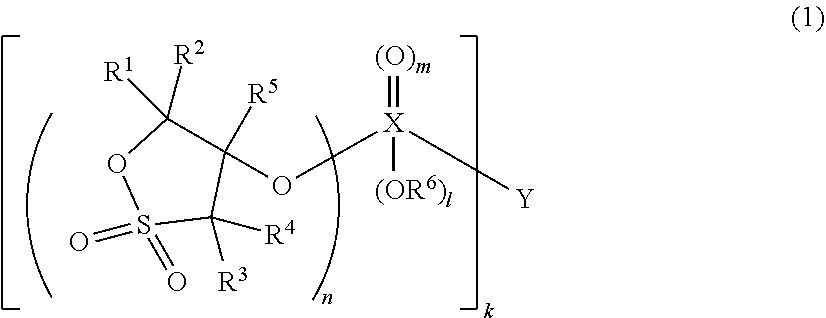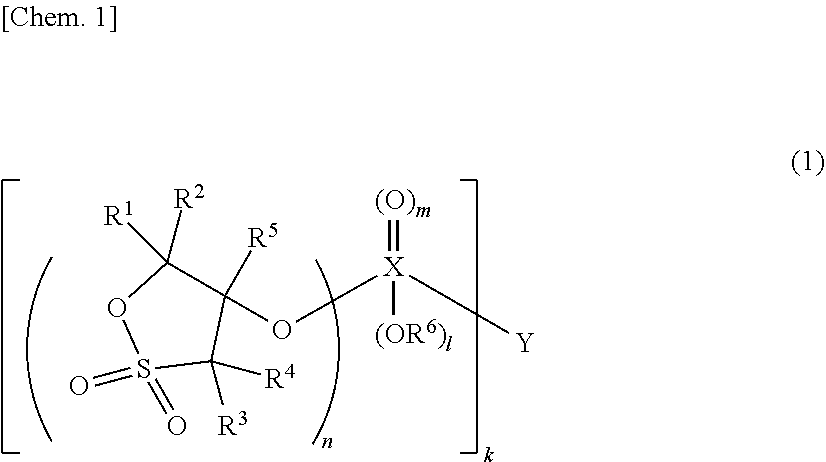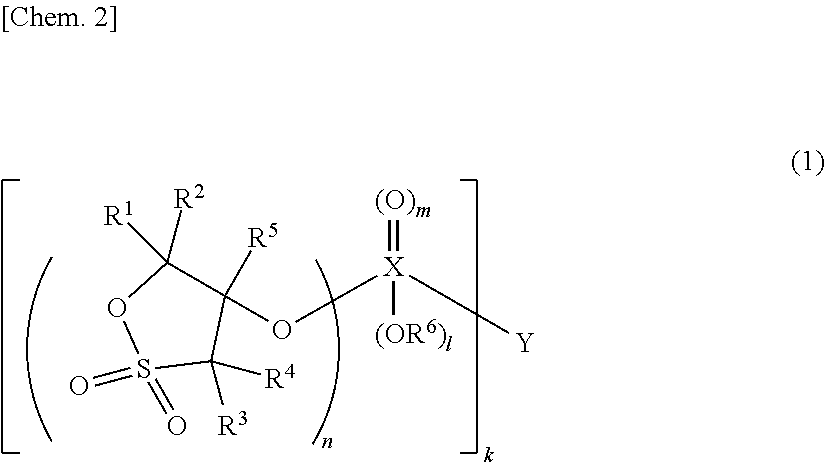Nonaqueous electrolytic solution and energy device including the same
a technology of electrolysis solution and energy device, which is applied in the direction of electrochemical generators, cell components, batteries, etc., can solve the problems of reducing the capacity and increasing the amount of decomposition gas, and accelerating the side reaction between the positive electrode and the electrolytic solution, so as to reduce the generation of gas, improve the discharge capacity retention factor, and improve the resistance characteristics
- Summary
- Abstract
- Description
- Claims
- Application Information
AI Technical Summary
Benefits of technology
Problems solved by technology
Method used
Image
Examples
synthesis example 1
[0403]In a nitrogen atmosphere, 1.0 g (7.2 mmol) of 2-hydroxy-1,3-propanesultone was charged into a 50-ml three-necked flask and then dissolved in 20 ml of THF. The resulting solution was cooled to less than 10° C. with an ice bath. Subsequently, 0.76 g (3.5 mmol) of methanedisulphonyl dichloride / 5 ml of THE was added to the solution. Then, a 0.81 g (8.0 mmol) of triethylamine / 10 ml of THE solution was slowly added dropwise to the solution such that the internal temperature did not exceed 10° C. After stirring had been performed for 2 hours at less than 5° C., 20 ml of water was added to the solution. Then, extraction was performed 3 times with 20 ml of dichloromethane. The resulting organic layer was concentrated until the precipitation of a white solid was confirmed. The white solid was recovered by performing filtration under reduced pressure and then dried in vacuum. Hereby, 0.38 g of a compound (1-1) was prepared with a yield of 25.9% in the form of a white solid.
[0404]1H-NMR (...
synthesis example 2
[0405]In a nitrogen atmosphere, 2.17 g (15.7 mmol) of 2-hydroxy-1,3-propanesultone was charged into a 100-ml three-necked flask and then dissolved in 30 ml of THF. The resulting solution was cooled to less than 10° C. with an ice bath. Subsequently, 2.4 ml (17.2 mmol) of triethylamine was added to the solution. Then, a 2.0 g (7.8 mmol) of 1,4-butanedisulfonyl dichloride / 20 ml of THE solution was slowly added dropwise to the solution while the internal temperature was controlled not to exceed 10° C. After the addition, stirring was performed for 2 hours at less than 10° C. To the stirred solution, 30 ml of ethyl acetate / 20 ml of water was added and stirring was performed. The resulting insoluble white solid was recovered by performing filtration under reduced pressure. The filtrate was also concentrated, and the precipitated white solid was recovered by performing filtration under reduced pressure. In total, 1.26 g of the white solid was obtained. This solid was suspended in 10 ml of...
synthesis example 3
[0407]In a nitrogen atmosphere, 1.0 g (7.2 mmol) of 2-hydroxy-1,3-propanesultone was charged into a 100-ml three-necked flask. To the flask, 35 ml of dichloromethane was added. The resulting solution was cooled to less than 10° C. with an ice bath. Subsequently, 0.81 g (8.0 mmol) of triethylamine / 5 ml of dichloromethane was added to the solution while stirring was performed. Then, 0.45 g (3.5 mmol) of oxalyl chloride / 5 ml of dichloromethane was slowly added dropwise to the solution such that the internal temperature did not exceed 10° C. Subsequently, stirring was performed for 5 hours at room temperature. The reaction solution containing a white solid was filtered. The resulting solid was washed with water. Hereby, 0.4 g of a compound (1-3) was prepared with a yield of 34.2% in the form of a white solid.
[0408]1H-NMR (DMSO-d6, 400 MHz): 5.84-5.81 (m, 2H), 4.75-4.71 (m, 2H), 4.68-4.65 (m, 2H), 4.01-3.96 (m, 2H), 3.81-3.76 (m, 2H). MS(DCI): m / z 331.0 (M+H)+.
PUM
| Property | Measurement | Unit |
|---|---|---|
| battery voltage | aaaaa | aaaaa |
| temperature | aaaaa | aaaaa |
| temperature | aaaaa | aaaaa |
Abstract
Description
Claims
Application Information
 Login to View More
Login to View More - R&D
- Intellectual Property
- Life Sciences
- Materials
- Tech Scout
- Unparalleled Data Quality
- Higher Quality Content
- 60% Fewer Hallucinations
Browse by: Latest US Patents, China's latest patents, Technical Efficacy Thesaurus, Application Domain, Technology Topic, Popular Technical Reports.
© 2025 PatSnap. All rights reserved.Legal|Privacy policy|Modern Slavery Act Transparency Statement|Sitemap|About US| Contact US: help@patsnap.com



